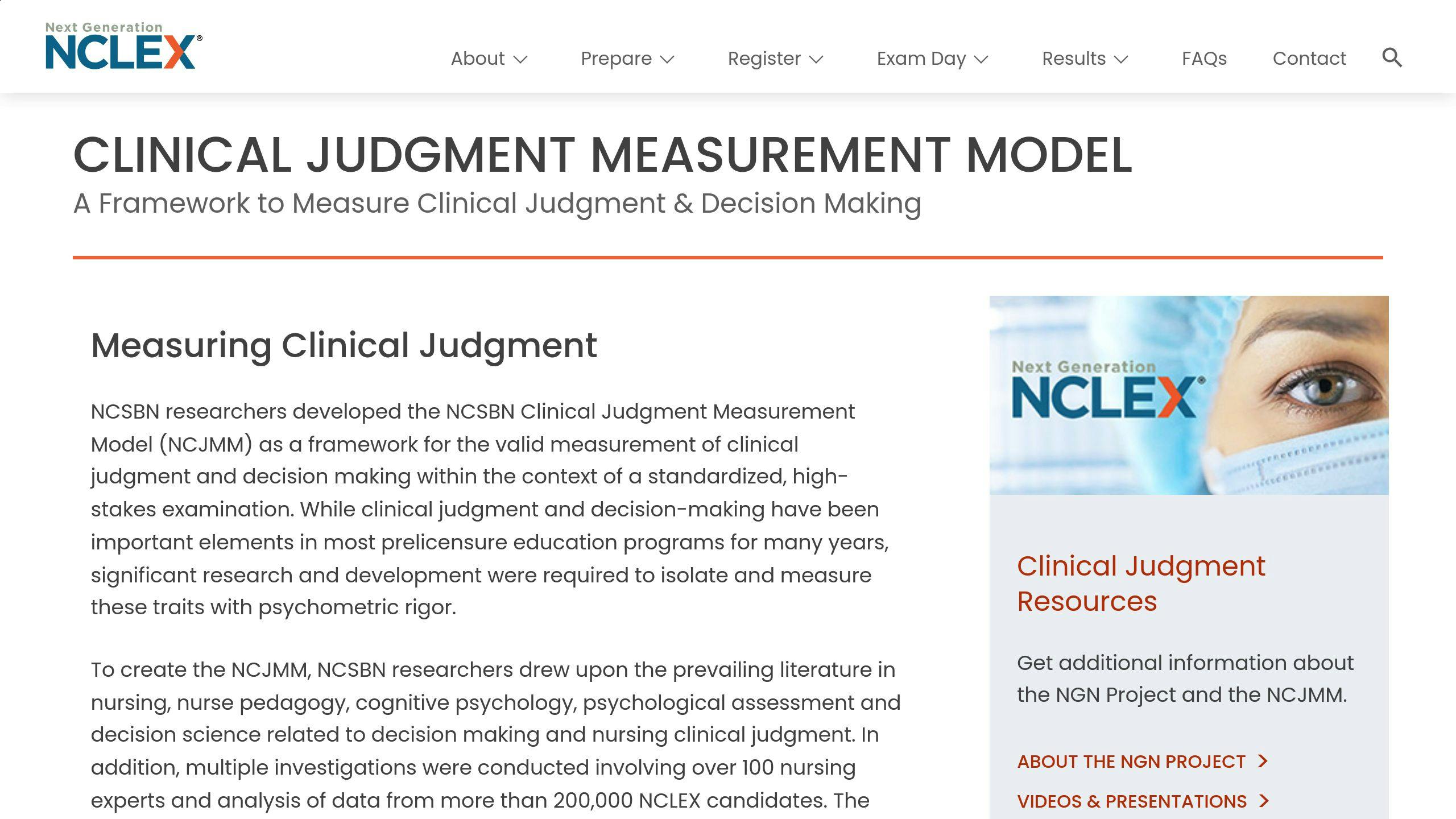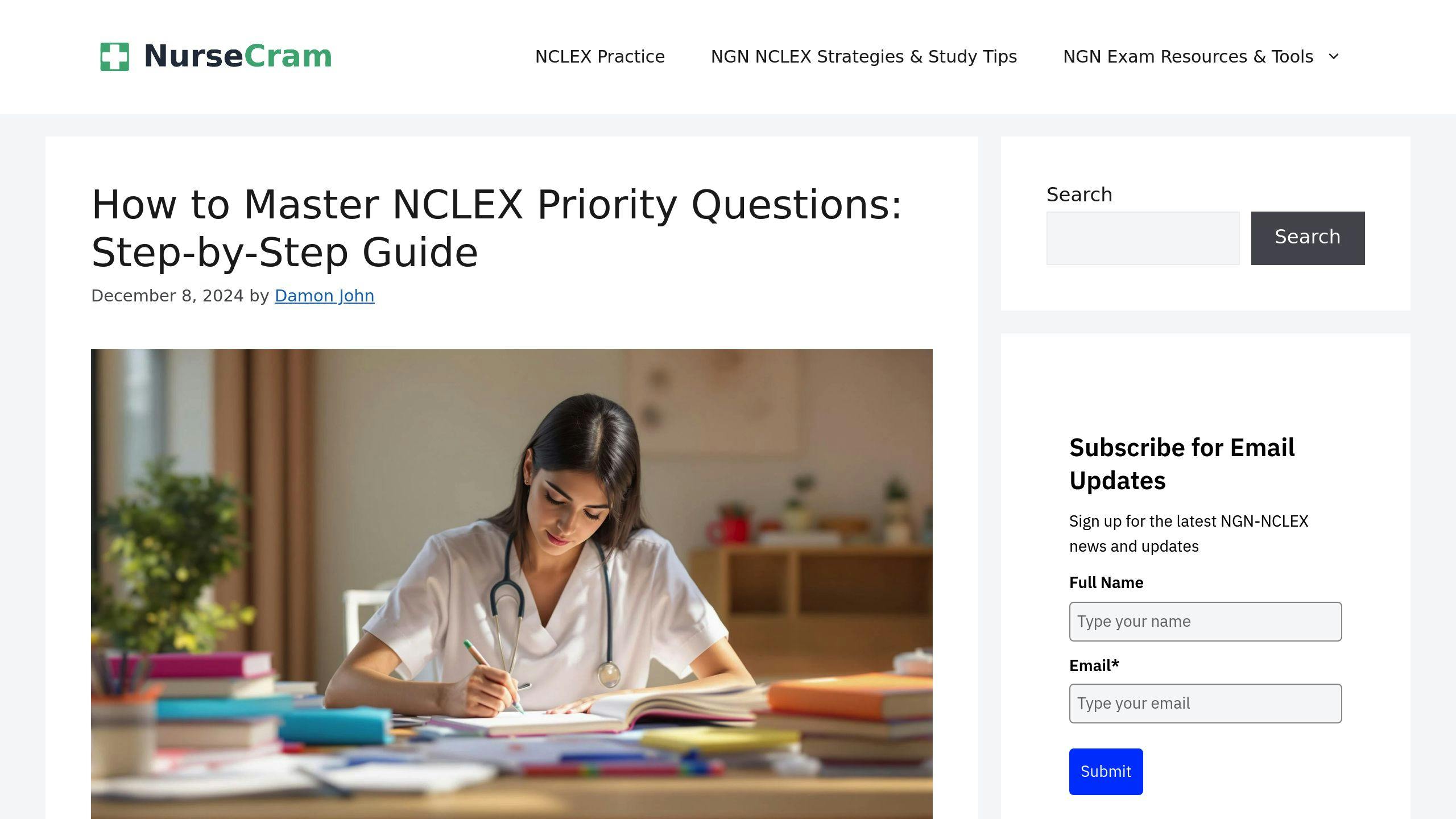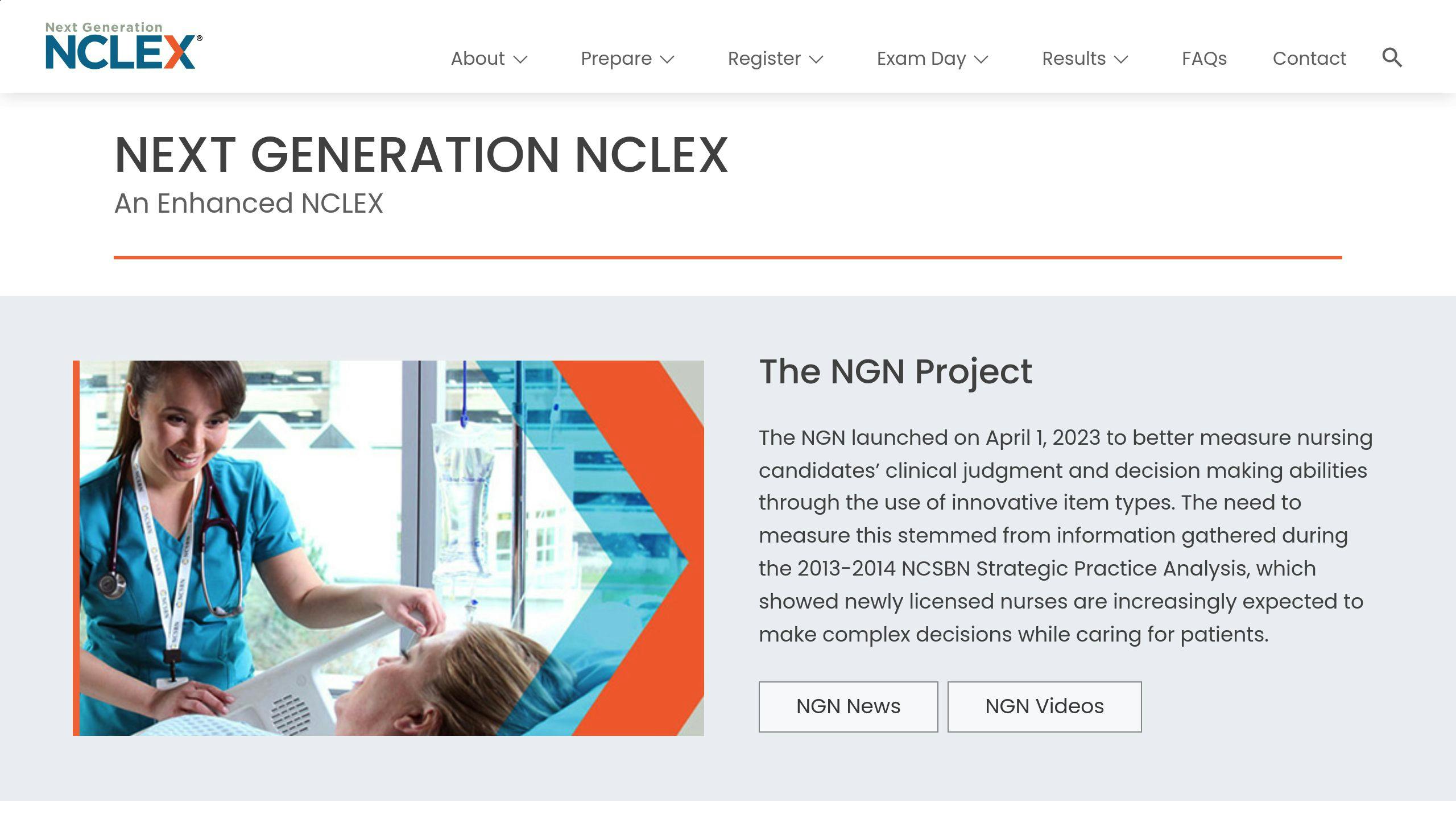NGN case studies are a new testing format introduced in April 2023 to prepare nursing candidates for practical, real-world decision-making. These case studies assess clinical judgment through realistic patient scenarios and are essential for NCLEX success. Here’s what you need to know:
- What They Include: Patient scenarios, medical history, decision-making questions, and evidence-based assessment criteria.
- Purpose: Evaluate critical thinking, clinical judgment, and decision-making in complex situations.
- Framework: Built on the Clinical Judgment Measurement Model (CJMM), focusing on identifying patient cues, analyzing data, and planning interventions.
- Question Types: Matrix grids, drag-and-drop, and bow-tie questions simulate real-life nursing tasks.
To succeed, practice with tools like NurseCram‘s NCLEX review, use simulation exercises, and focus on analyzing patient data, prioritizing interventions, and making evidence-based decisions.
Elements of Effective NGN Scenario Use
Understanding the Clinical Judgment Measurement Model (CJMM)

NGN case studies are built around structured frameworks like the Clinical Judgment Measurement Model (CJMM). Created by the NCSBN, CJMM evaluates a candidate’s clinical decision-making abilities through three key phases: identifying patient cues, analyzing clinical data, and determining appropriate interventions [2].
This model ensures that the evaluation focuses on practical decision-making, while NGN question formats are crafted to test these skills in realistic scenarios.
NGN Question Types and Their Assessment Role
The NGN exam uses several question formats to assess different aspects of clinical judgment:
| Question Type | What It Evaluates | How It’s Applied |
|---|---|---|
| Matrix Grid | Organizing information | Sorting and prioritizing patient data |
| Drag-and-Drop | Sequencing care steps | Planning interventions logically |
| Bow-tie Questions | Cause-and-effect links | Connecting symptoms to outcomes |
These question types mirror real nursing tasks, encouraging critical thinking and problem-solving [2]. Each format is carefully aligned with the phases of CJMM, ensuring a comprehensive assessment of clinical judgment. This approach prepares nursing students to handle the challenges of actual practice while maintaining a consistent evaluation framework.
Mastering these elements requires both analytical thinking and the ability to apply knowledge in practical scenarios.
Tips for Mastering NGN Case Studies
Building Critical Thinking and Clinical Judgment
According to the NCSBN Strategic Practice Analysis, success in NGN case studies comes down to thoroughly assessing clinical situations and making informed decisions [2].
Here’s a breakdown of the clinical decision-making process:
| Phase | Strategy | Action |
|---|---|---|
| Data Collection | Identify key information | Spot essential symptoms |
| Analysis | Process the data | Link symptoms to potential causes |
| Action Planning | Set priorities | Focus on immediate concerns |
| Evaluation | Review the outcome | Analyze the effectiveness of actions |
NurseCram NCLEX Exam Review: A Resource Worth Exploring

NurseCram stands out by emphasizing clinical judgment through realistic and practical exercises. It provides:
- Exercises designed to reflect NCLEX-style scenarios
- Clear explanations for clinical reasoning behind each answer
- Regular updates to align with current clinical standards
To get the most out of NGN case study practice:
- Work through each scenario completely before checking the answers.
- Pay attention to the reasoning behind both correct and incorrect options.
- Practice regularly with a variety of case scenarios to strengthen your skills.
Adding simulation-based exercises to your study routine can further sharpen your clinical judgment and boost your confidence for the NGN exam.
The Use of Simulation in NGN Preparation
How Simulation Enhances Clinical Skills and Confidence
Simulation-based learning connects classroom knowledge with hands-on practice, helping nursing students better assess, prioritize, and handle complex patient situations [2].
Here’s why simulation works so well for NGN preparation:
| Feature | Advantage | How It’s Used |
|---|---|---|
| Practical Experience | Safe space for learning and mistakes | Practice clinical judgment in lifelike scenarios |
| Instant Feedback | Learn from real-time evaluations | Adjust and improve decision-making on the spot |
| Realistic Challenges | Mimics varied patient conditions | Build flexible and effective clinical responses |
Aligning Simulation with NGN Scenarios
Simulation exercises designed to match NGN case study formats give students an immersive way to practice clinical judgment in a realistic, exam-oriented setting. These exercises mirror the kinds of challenges nurses face in real-world practice.
Modern simulation tools include:
- Virtual patient cases modeled after NGN scenarios
- Interactive systems that provide immediate feedback
- Debriefing sessions to review decisions and strengthen critical skills
To get the most out of simulation, focus on sharpening clinical judgment, managing time wisely, and using debriefing sessions to fine-tune your approach. Incorporating these exercises into NGN prep helps students build the skills needed for both exam success and practical nursing.
sbb-itb-aa73634
How to Solve Case Studies in NCLEX 2025: 10 New Strategies with Example
Conclusion: Key Points for NGN Scenario Success
Since April 2023, the NGN has shifted how nursing competency is assessed, putting a strong focus on practical decision-making in real-world settings [2]. Using the CJMM framework as a foundation, NGN scenarios rely on structured clinical judgment skills to measure nursing competency.
Here are the main components for success in NGN scenarios:
| Component | Application | Impact |
|---|---|---|
| Clinical Judgment | Careful evaluation of patient data | Improved decision-making |
| Practical Application | Use of case studies and simulations | Strengthened critical thinking and confidence |
To prepare effectively, using tools like NurseCram’s NCLEX Exam Review can be helpful. This resource provides scenario-based exercises and detailed explanations, designed to sharpen critical thinking and enhance clinical judgment – key areas of the NGN exam.
When working through cases, focus on these steps:
- Identify key findings: Pinpoint the most relevant patient data.
- Prioritize interventions: Determine the most urgent actions.
- Make evidence-based decisions: Base your choices on solid evidence and best practices.
FAQs
What is a Next Generation NCLEX (NGN) examination style case study?

The Next Generation NCLEX (NGN) case study, introduced in April 2023, is a testing format designed to assess clinical judgment through realistic scenarios presented in stages [1][2].
NGN case studies include the following components:
| Component | Description | Purpose |
|---|---|---|
| Clinical Scenarios | Realistic patient situations | Tests practical application |
| Patient Data | Gradual release of information | Evaluates analytical skills |
| Clinical Analysis | Use of nursing knowledge | Assesses decision-making ability |
These case studies are built around the Clinical Judgment Measurement Model (CJMM), particularly Layer 3, to measure a candidate’s ability to:
- Critically analyze complex patient situations.
- Make decisions based on evidence and clinical reasoning.
- Apply nursing knowledge effectively in real-life scenarios.
"Clinical judgment is critical to nursing." – NCSBN, Next Generation NCLEX [2]
Understanding NGN case studies is crucial for NCLEX preparation. These scenarios reflect challenges nurses face in real-life practice, requiring candidates to sharpen their clinical judgment and apply it within the exam’s structured format. This ensures readiness not just for the test, but also for professional nursing roles [2].
Related posts
- Mastering Clinical Judgment in NGN Case Studies
- How to Use Clinical Judgment in NGN Case Studies
- Ultimate Guide to Scenario-Based NCLEX Prep
- Bridging Theory and Practice in NGN Case Studies

Sophia is the compassionate and knowledgeable face of NurseCram.com. With a passion for helping nursing students excel, she serves as a supportive mentor, providing practical guidance and insights for mastering the NGN NCLEX exams. Her approachable dedication and dedication to education make her the perfect guide for future nurses striving to achieve their dreams. Sophia is here to simplify your learning journey and empower you to succeed!

